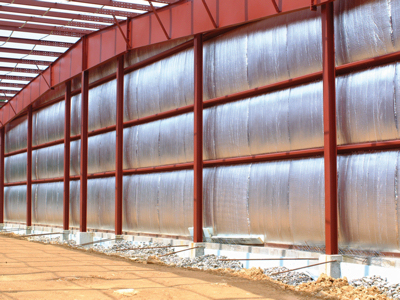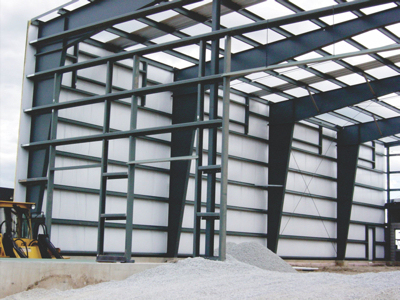Price, Simplicity And Performance Behind Growing Popularity Of Reflective Insulation Products
By John Starr, Covertech/rFoil
During the past few years, more and more companies have found the solution for keeping the desired temperature inside their buildings while keeping energy cost down. The solution is reflective insulation products. Reflective insulation products are gaining popularity for their energy savings benefits, ease of installation and competitive pricing.
| | 
|
| | Reflective insulation systems are available with standard foil facings (above) or with a white facing for a more finished appearance (below). Click images to enlarge. |
| | 
|
Because metal buildings conduct heat, maintaining desired temperatures during the summer and winter months can be ongoing and expensive. Reflective insulation works by reducing the transfer of heat across a building's air spaces. Reflective insulation is manufactured with highly reflective surfaces. Since 95-97 percent of the radiant heat that strikes the surface is reflected, only 3 to 5 percent of the heat is emitted through the insulation.
The major benefits of reflective insulation is that in the summer, heat that's radiated through the roof is reflected off the insulation's surface back to the roof, not to the inside of the building, keeping temperatures inside the building cooler. In the winter, heat inside a metal building is reflected off the insulation's shiny surface back into the building so that the heat is retained inside.
To achieve maximum performance, the reflective insulation must be properly installed with an airspace facing one foil side of the product. In addition to its energy saving capabilities, reflective insulation has many other features. Primary ones are…
• Easy to install, resulting in lower labor cost.
• Lightweight and can be cut to fit any configuration.
• It can be installed over previous insulation to increase insulating properties, or to improve a buildings appearance.
• The reflective surface can reduce interior lighting requirements by as much as 35 percent, helping to reduce energy costs.
• The low moisture transfer improves the overall thermal performance of the building.
While reflective insulation materials can be used in any climate, it is most effective in southern states where excessive heat can send energy cost soaring.
Reflective insulation materials are tested under the ASTM 1224 Standard Specifications for reflective insulation for building applications. Included in these criteria is a fire test. ASTM E84-09 and ASTM E2599 require reflective insulation to have a flame spread rating of 25 or less, and a smoke development rating of 50 or less.
John Starr is the vice president of Covertech/rFOIL Reflective Insulation and Radiant Barrier Products, Etobicoke, Ontario, Canada. To learn more, visit www.rfoil.com.
Covertech is a member of the Reflective Insulation Manufactures Association International (RIMA-I), the only worldwide trade association representing the reflective insulation, radiant barrier and interior radiation control coating industries. RIMA-I provides guidelines and information about reflective products and manufactures in the industry. Readers are encouraged to visit the association website at www.rimainternational.org and check out the 'Technical Info' section for their handbook and technical bulletin, articles and test information. RIMA-I has also recently introduced a Verification Program. This program has been established to identify reflective products that have fulfilled test requirements in accordance with the current applicable code standards. Members can voluntarily apply for verification, which is conducted by a third-party accredited laboratory on RIMA-I's behalf, to establish that products meet or exceed code requirements. To learn more about this program and what products have been verified to date, click the website's 'Verified Products' link. For more information or personal assistance, contact the association at (800) 279-4123 or via email at rima@rima.net.
About RIMA-I
 RIMA-I represents reflective insulation, radiant barrier and interior radiation control coating (IRCC) manufacturers and other companies that are active within the industry. RIMA-I exists to educate the
marketplace on the benefits of reflective technologies and to represent member's interests in establishing ASTM standards for testing and installation procedures. For more information, visit www.rimainternational.org.
RIMA-I represents reflective insulation, radiant barrier and interior radiation control coating (IRCC) manufacturers and other companies that are active within the industry. RIMA-I exists to educate the
marketplace on the benefits of reflective technologies and to represent member's interests in establishing ASTM standards for testing and installation procedures. For more information, visit www.rimainternational.org.